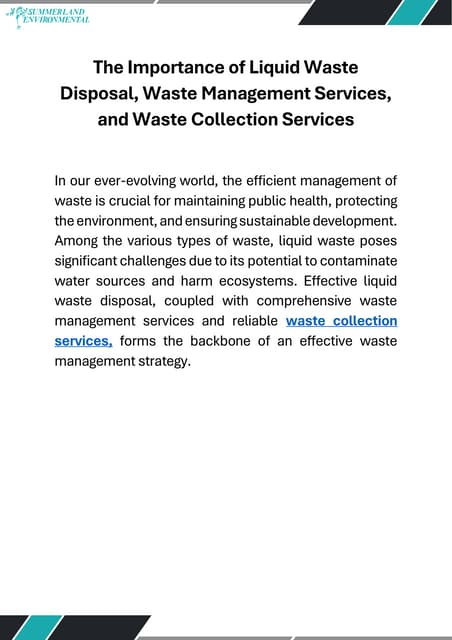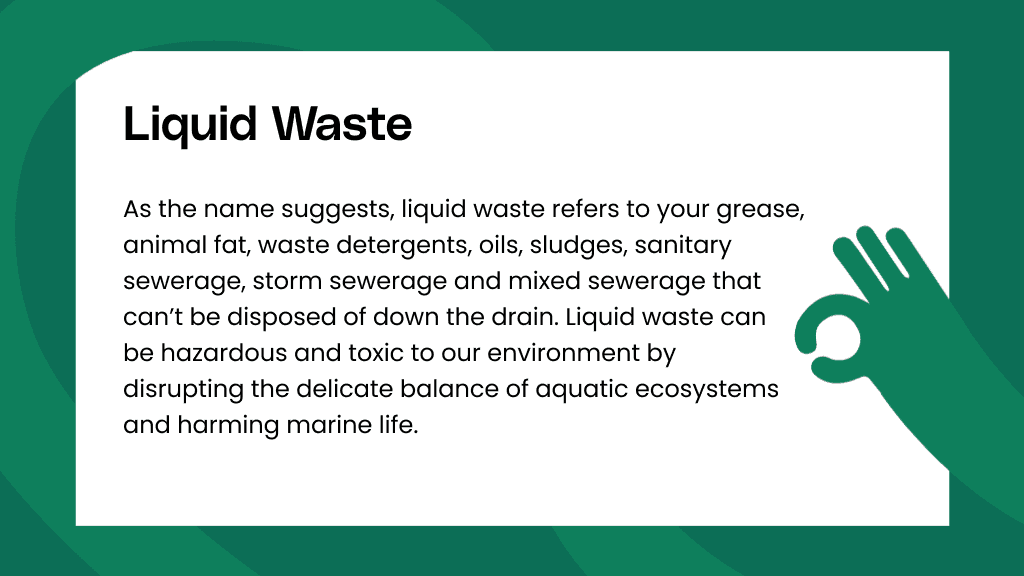All About Reclaim Waste
All About Reclaim Waste
Blog Article
Reclaim Waste for Dummies
Table of ContentsThe 30-Second Trick For Reclaim WasteEverything about Reclaim WasteReclaim Waste - TruthsReclaim Waste Can Be Fun For AnyoneFascination About Reclaim Waste
Residential sewage waste refers to the waste and items from a property septic storage tank. The correct management and disposal of residential sewer waste need fluid waste to be moved to a sewer treatment plant where the proper techniques and devices are applied to purify and dispose of waste.
Business waste commonly consists of potential dangers, such as flammable products or a mixture of fluid and strong waste items, and requires an advanced and detailed disposal procedure. The disposal of commercial waste commonly includes the filtering of waste before transportation to make certain risk-free and proper disposal. Industrial waste is developed from by-products and drainage of commercial processes and production.
This type of waste can not use the very same sewer administration transport or procedures as septic or commercial fluids. The industrial waste management procedure requires the examination and screening of fluid waste prior to it undergoes the disposal procedure (industrial wastewater treatment). Overflow waste is the liquid waste that originates from drainage and excess stormwater in very booming locations or cities
Runoff waste can cause contamination and flooding otherwise handled properly. Learn a lot more regarding sewage system cleaning and waste administration. Guaranteeing appropriate waste monitoring can avoid calamities and lower ecological damage. Both individuals in household setups and professionals in industrial or production industries can gain from recognizing the procedures and laws of liquid waste monitoring.
Some Known Facts About Reclaim Waste.
Contact PROS Providers today to learn concerning our waste administration and disposal solutions and the appropriate means to take care of the fluid waste you produce.
(https://www.twitch.tv/reclaimwaste1/about)This supposed 'wastewater' is not only a vital source but, after therapy, will be launched to our land, waterways or the sea. Utilized water from toilets, showers, baths, kitchen sinks, washings and industrial processes is recognized as wastewater.

water made use of to cool equipment or tidy plant and tools). Stormwater, a type of wastewater, is runoff that streams from farming and metropolitan locations such as roofings, parks, yards, roads, courses and gutters right into stormwater drains pipes, after rainfall. Stormwater flows unattended directly to regional creeks or rivers, eventually getting to the ocean.
Facts About Reclaim Waste Revealed
In Queensland, many wastewater is dealt with at sewer treatment plants. Wastewater is moved from residential or commercial websites through a system of sewers and pump stations, recognized as sewage reticulation, to a sewer treatment plant.
The Division of Natural Resources suggests local governments about managing, operating and maintaining sewage systems and therapy plants. In unsewered areas, city governments may need owners to mount private or home sewer treatment systems to treat residential wastewater from bathrooms, kitchens, restrooms and washings. The Department of Natural Resources authorises the use of household systems when they are confirmed to be reliable.
The majority of stormwater gets no treatment. In some new class, treatment of some stormwater to remove litter, sand and gravel has actually begun making use of gross toxin traps. Wastewater therapy occurs in 4 phases: Gets rid of solid matter. Bigger solids, such as plastics and other objects mistakenly discharged to sewage systems, are removed when wastewater is gone through screens.
Wastewater then flows right into large storage tanks where solids work out and are gotten rid of as sludge. Grease and scum are skimmed from the surface area. Uses small living organisms called micro-organisms to damage down and remove continuing to be liquified wastes and fine bits. Micro-organisms and wastes are incorporated in the sludge. Removes nitrogen and phosphorus nutrients that might create algal blooms in our waterways and intimidate water life.
Examine This Report about Reclaim Waste
Nutrient removal is not available in all sewage therapy plants since it calls for expensive specialist tools. It is ending up being more typical in Queensland. Clear liquid effluent produced after treatment might still consist of disease-causing micro-organisms. If this effluent is launched right into rivers such as rivers or the sea, the micro-organisms will at some check my site point pass away out.

This typically implies wastewater has to be dealt with or contaminants removed prior to it can be released to rivers. The majority of wastewater moves right into the sewerage system. Under the Act, local governments provide authorizations and permits for eco pertinent activities (Periods) involving wastewater releases that may have a regional impact. The division carries out authorizations and licences to Periods including wastewater releases that might have a regional or statewide influence.
The Greatest Guide To Reclaim Waste
Otherwise, examples are considered lab evaluation. Often lots of examinations are needed to establish the levels of each of the various pollutants such as oils, hefty steels and pesticides in water. Tracking provides factual information regarding water top quality and can validate that licence conditions are being satisfied. The info gotten via surveillance provides the basis for making water quality decisions.
Report this page